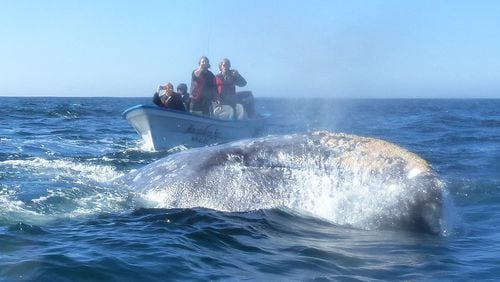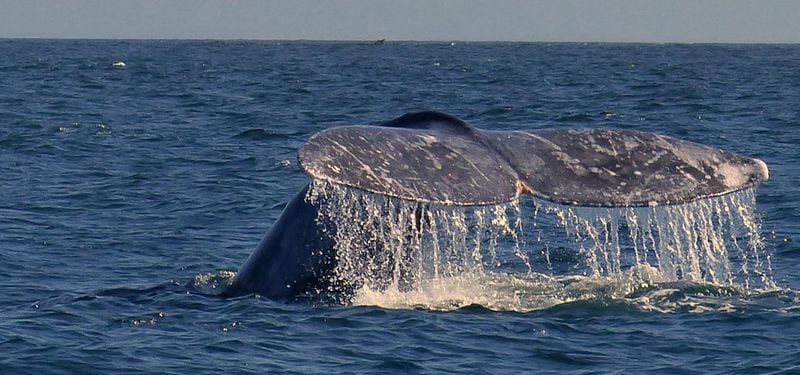MAGDALENA BAY, Mexico — Just off the bow of our 22-foot open boat — what Baja fishermen call a “panga” — a whale spout erupts with an adrenalin-spiking “fwooosh.” Seawater jets into the air, catching the brilliant Mexican sun in a fleeting rainbow.
“Woo-hoo!” I yelp. (Sometimes I can’t help myself.)
As the gray whale’s barnacle-armored back slices the water less than 20 feet away, in the near distance my eye takes in a scissor-sharp line of barren coastal peaks. A thought occurs: This is a bit like visiting another planet, where alien life-forms seem just as interested in us as we in them.
Indeed, for a visitor from Seattle, the burnt-sienna crags of coastal Baja seem like another world compared with the Pacific Northwest’s emerald and gray coastline. And the whales that surround our boat — not fleeing, often lolling just beneath us, sometimes surfacing so close they can look us in the eye — are intriguing visitors from a watery world.
I was on a daylong adventure on this wide and wild 30-mile-long bay on the lower reaches of Baja California. To this coast, after one of the longest migrations of any mammal on Earth — more than 5,000 miles each way — as many as 20,000 gray whales from cold Alaska seas come every winter to mate and have their calves.
Magdalena Bay is one of the places where curious humans pay homage to them. And it seems the curiosity is mutual: It’s common here for whales to come right up to boats, sometimes letting humans pat them on the head.
———
A REFUGE FROM THE SEA
I was last in Magdalena Bay 22 years ago when my family and I piloted our 32-foot sailboat from San Diego 850 miles down Baja’s wild Pacific Coast and into the Sea of Cortez. Mag Bay, as it’s known among sailors, offered us a few days of welcome refuge from capricious wind and waves.
Most of the huge bay was relatively untouched by human development then. It has changed little, still lined with sand dunes and mangroves, its skies filled with pelicans and frigate birds, its waters with sea lions and clams.
For this visit, I’d flown the previous (very long) day on Alaska Airlines via Los Angeles into the Sea of Cortez town of Loreto, then rented a car for the 2 1/2-hour drive across the peninsula to the small fishing town of Puerto San Carlos.
Something I’m pretty sure wasn’t the case when last I was here: The highway was paved all the way. From the bay’s outer reaches on my earlier visit I also hadn’t seen the big diesel-powered electric plant on the inland edge of town. Luckily for the town and bay, prevailing winds blow its plumes of brown smoke inland.
But once you’re out on the vast bay, there’s a look and feel of wilderness.
Online research had led me to a locally run tour service, Magdalena Bay Whales, managed by 40-year-old “Captain Marco” (full name: Crispin Marco Antonio Mendoza Lopez). His fisherman father, Crispin Mendoza, 78, was the first local who started taking tourists out to see gray whales here in 1970. He got the job because gringo visitors had begun asking for whale-watching rides and he was the only fisherman in town who spoke good English.
He has come to be known as the Whale Whisperer.
“I feel like I can talk to the whales and I feel they can listen to me,” he told me over dinner one night. “I talk to the whales like I talk to my little puppy at home: ‘Come on, baby, let’s play!’ ”
These days, his son is an affable and enterprising businessman. Book a whale-watching outing with his company online and he’ll also book you into his family’s little hotel, Hotel Isabela. Don’t expect the Hilton. Just to find the place, you have to stop by the whale-tour office in town and someone will lead you through a maze of dirt streets and ragtag cinder-block homes typical of rural Mexico.
The hotel rooms are modern and well-furnished (except for the shortage of reading lamps). But don’t anticipate more than a drizzle from the shower. And the best I could find on the TV was a fuzzy-picture tribute to Mexican boy bands (does anybody really miss Menudo?).
But put aside a few First World expectations. The friendly folks who run the place make up for all that, the food in the little palapa-style restaurant is tasty, and breakfast is included in your stay.
———
OUT TO SEA
At 7 a.m. we meet in the restaurant before our day of whale-watching. I’ll be in one boat and another will carry a family from Los Angeles: a mom, dad, their grown daughter (named Kia, like the car) and her husband (Dakota, like the states).
Kia and Dakota are adventure-tourism junkies. They’ve just come from La Paz, a few hours to the south, where they went diving with whale sharks. They’ve done a shark-cage encounter in Hawaii, with Galapagos sharks, and a dolphin encounter.
“What we want to do next is off the coast of California, a shark-cage dive with great whites!” Dakota tells me as I munch my huevos rancheros.
I’m conflicted, hoping this outing goes beyond belt-notching. That it will be life-affirming, not exploitative.
Captain Marco sits and tells us about Mag Bay’s whales.
“We started to see whales at the end of December, and this year we see a little bit more than the usual. In the area we can go, there are 25 to 30 whales right now.”
It’s late January when I visit. He says we’re too early to see many calves, which usually appear more around mid-February. Around far-flung corners of the bay there might be as many as 250 whales, he says, but government regulations bar whale-watching boats from areas where mother whales typically take their calves to nurse.
I’ve chosen his outfit because online reviews said the boat captains respect the whales. But I’m also concerned about a reviewer who said she had seen whales bloodied by boat propellers on Mag Bay.
Captain Marco tells us that regulations require boats to stay 30 meters away from whales (about 98 feet). U.S. standards in areas such as the San Juan Islands require boats to stay 200 yards away (1,200 feet).
“If whales approach us or want to interact with us, that’s allowed,” Marco explains.
Currently in his area, 32 boats have permits to take tourists whale watching. Of every 10 tours, he says, maybe seven have whales come right up to the boat.
That’s an adult whale of 35 to 45 feet, or a calf of 8 to 12 feet, getting friendly with a 22-foot skiff. Surprisingly, accidents are rare.
———
DIAMONDS ON THE WATER
Captain Juan is at the helm of my boat. Captain Marco’s niece, 13-year-old Merary, accompanies us as we launch from the edge of a mangrove lagoon at 8:30 a.m.
The sun, still low in the east, glints diamonds off the serene bay. Far shores are lost in mist. Pelicans, a blue heron and a white egret perch among mangrove branches.
Captain Juan soon gooses the outboard to put the panga up on plane. We race the other boat across the bay in water shallow enough that I can see waves cast spidery shadows on the sandy bottom. The air is cool; I’m thankful I’ve been warned to wear layers.
We pause to inspect sandy Isla de Patos, with thousands of pelicans and cormorants clustered ashore, then circle a channel marker where we bark back and forth at tawny sea lions who bask on its base.
We see another tourist boat with visitors in orange life vests. No life vests are offered on my boat, nor is there any discussion of safety.
At 9:05, near the bay’s entrance, Juan cries out. I spy a fluked tail breaking the water a half-mile ahead. Merary points to the spray of whale spouts off to our left. For the next three hours, we slowly cruise the mouth of the bay as whales appear, some in the distance, some right next to our boat. At one point around us I count six more pangas with tourists. None are chasing whales at high speed. Most maintain their distance unless the whales approach them.
We see myriad tale flips, we see lumbering giants loafing beneath our boat, we see a distant breach — and for one dramatic moment a whale thrusts its colossal, barnacled beak up over the transom of our panga, as if to give Captain Juan a big wet kiss.
Whoa, did that just happen?
“Bonita! Bonita!” chants Merary, calling whales to us, using the Spanish word for “pretty.”
When we’re all getting a tiny bit jaded, Captain Juan gets out his iPod, holds it up to the microphone of his marine radio and broadcasts Mexican hip-hop to our partner boat. The Angelenos all start jiving and doing their version of a whale dance. We laugh across the water.
Very different species of Earthlings checking each other out? I’ll come down on the side of life-affirming.
Credit: Brian J. Cantwell
Credit: Brian J. Cantwell
IF YOU GO
Where
Magdalena Bay can be reached by car in a few hours of driving on paved highways from airports at Loreto, La Paz or San Jose del Cabo, in the Mexican state of Baja California Sur. Puerto San Carlos, pop. 5,500, is the largest town on the bay.
Whale-watching guides
I went out with Magdalena Bay Whales (magdalenabaywhales.com), which charges $89.99-$99.99 U.S. per person for a 6-hour outing. Several other operators offer outings during whale season, January to April. Ask at any local hotel or look for signs around Puerto San Carlos.
Lodging
Lodging with breakfast at Hotel Isabela costs $59.99 U.S. a night. See magdalenabaywhales.com/hotel.html.
Among other options in Puerto San Carlos, with a pleasant location on the water's edge: Mar y Arena Hotel, villasmaryarena.com.
Also: Magdalena Bay Whales operates its remote, beachside Magdalena Whale Camp on the bay about a 30-minute boat ride from Puerto San Carlos. It features "comfort camping" in tents or yurts on raised wooden platforms. There's a dining palapa (where whale-watch boats stop for lunch), restrooms with flush toilets and hot showers. All-inclusive rates start at $495 U.S. per person, including two days of whale watching. magdalenabaywhales.com/magdalenawhalecamp.html







